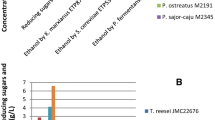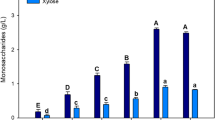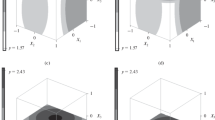Abstract
We extended our previous investigations of enzymatic hydrolysis of polysaccharides in orange peel by commercial cellulase and pectinase enzymes to higher, more practical concentrations of orange peel solids. High yields of saccharification could be maintained even at substrate concentrations as high as 22–23%, but the rates of solubilization and saccharification decreased 2-3-fold. We also tested the fermentability of these hydrolysates by the yeastSaccharomyces cerevisiae, which revealed the presence of inhibitory compounds. These compounds could be removed by the filtration of hydrolyzed peel. Successful fermentations of filtered hydrolysates were achieved after pH adjustment with calcium carbonate.
Similar content being viewed by others
References
Agricultural Research Service (1962),Chemistry and Technology of Citrus, Citrus Products and Byproducts. Agriculture Handbook No. 98, United States Department of Agriculture Publ., Washington, DC, p. 98.
Kesterson, J. W. and Braddock, R. J. (1976),By-Products and Specialty Products of Florida Citrus. Bulletin #784, University of Florida Publ., Gainesville, FL, p. 119.
Grohmann, K. and Baldwin, E. A. (1992),Biotechnol. Lett. 14, 1169–1174.
Nishio, N., Oku, Y., Kawamara, D., and Nagai, S. (1979),Hakko Kogaku Kaishi 57, 354–359.
Nishio, N. and Nagai, S. (1979),Eur. J. Appl. Microbiol. Biotechnol. 6, 371–378.
Marshall, M. R., Graumlich, T. R., Braddock, R. J., and Messersmith, M. (1985),J. Food Sci. 50, 1211,1212.
Echeverria, E., Burns, J. K., and Wicker, L. (1988),Proc. Fla. State Hort. Soc. 101, 150–154.
Akao, T., Mizuki, E., Saito, H., Okumura, S., and Murao, S. (1992),Bioresource Technol. 41, 35–39.
Ben-Shalom, N. (1986),J. Food Sci. 51, 720,721, 730.
Nelson, N. (1944),J. Biol. Chem. 153, 375–386.
Kohn, R. and Kovac, P. (1978),Chem. Zvesti 32, 478–485.
Grohmann, K., Wyman, C. E., and Himmell, M. E. (1992), inEmerging Technologies for Materials and Fuels from Biomass, Rowell, R. M., Schulz, T. P., and Narayan, R., eds., ACS Symp. Series No. 476, American Chemical Society Publ., Washington, DC, pp. 354–392.
Tong, G. E. and Cannell, R. P. (1988), inOrganic Chemicals from Biomass, Wise, D. L., ed., Benjamin/Cummings, Menlo Park, CA, pp. 407–451.
Rohatgi, N. K. and Ingham, J. D. (1992),Appl. Biochem. Biotechnol. 34/35, 515–526.
Von Loesecke, H. W. (1934),Citrus Ind. 15, 8,9, 20,21.
McNary, R., Wolford, R. W., and Patton, V. D. (1951),Food Technol. 5, 319–323.
Lane, A. G. (1980),J. Chem. Tech. Biotechnol. 30, 345–350.
Lane, A. G. (1983),Environ. Technol. Lett. 4, 65–72.
Mizuki, E., Akao, T., and Saruwatari, T. (1990),Biol. Wastes 33, 161–168.
Murdock, D. I. and Allen, W. E. (1960),Food Technol. 14, 441–445.
Subba, M. S., Soumithri, T. C., and Suryanarayana, R. (1967),J. Food Sci. 32, 225–227.
Shaw, P. E. (1979),J. Agric. Food Chem. 27, 246–257.
Scott, W. C. and Veldhuis, M. K. (1966),J. A.O.A.C. 49, 628–633.
Barnett, J. A., Payne, R. W., and Yarrow, D. (1985), inYeasts Characteristics and Identification, Cambridge University Press, Cambridge, UK, p. 811.
Carlson, M. (1987),J. Bacterial. 169, 4873–4877.
Hara, T., Fujio, Y., and Ueda, S. (1985),Nippon Shokahin Kogyo Gakkaishi 32, 241–246.
Sinclair, W. B. (1961), inThe Orange. Its Biochemistry and Physiology, Sinclair, W. B., ed., Univ. of California, Publ., Riverside, CA, pp. 191–229.
Author information
Authors and Affiliations
Rights and permissions
About this article
Cite this article
Grohmann, K., Baldwin, E.A. & Buslig, B.S. Production of ethanol from enzymatically hydrolyzed orange peel by the yeastSaccharomyces cerevisiae . Appl Biochem Biotechnol 45, 315–327 (1994). https://doi.org/10.1007/BF02941808
Issue Date:
DOI: https://doi.org/10.1007/BF02941808




